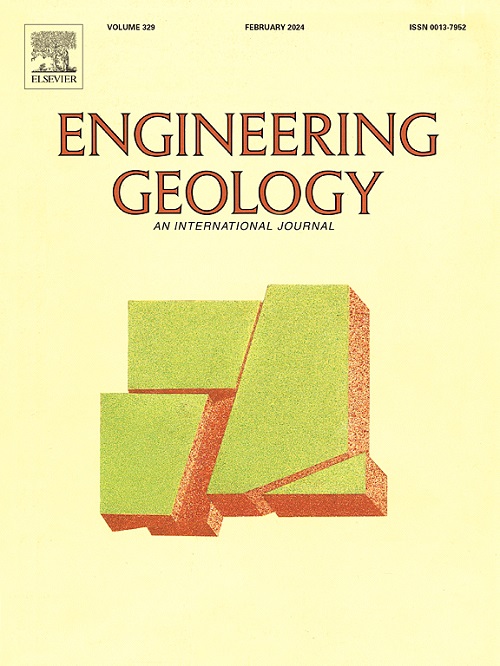Numerical study on the stiffening properties of scour protection around monopiles for Offshore Wind Turbines
IF 6.9
1区 工程技术
Q1 ENGINEERING, GEOLOGICAL
引用次数: 0
Abstract
An active marine seabed causing scour around monopile foundations has to be addressed as a geological hazard. These structures are often protected with rock armour to prevent foundation failure. However, scour protection also increases the confining pressure and embedment length, providing additional stiffness to the soil–pile system. This study focuses on the stiffening effect of scour protection to optimise foundation design. A parametric analysis of the dimensions and materials of scour protection is carried out with more than 100 simulations to assess the stiffening effect of scour protection. Therefore, small-diameter and large-diameter monopiles are investigated. Numerical analysis with the Finite Element method is conducted to estimate the natural frequencies and the static capacity through moment and lateral load () curves and the Load Utilisation method. These methods, which are new to the study of scour protection, are proposed for the quantification and assessment of scour protection in foundation design. The results show that rock fill restores the initial foundation conditions independently of the pile dimensions. While for small-diameter monopiles, scour protection fulfils its double purpose of preventing scour and providing stiffness to the foundation, for large-diameter monopiles the contribution to the stiffness is limited and should only be considered for heavy rock armour and significant scour protection heights. The parametric analysis indicates that a thicker and heavier scour protection increases the static capacity by 10%, whereas the width or a densification through sand accretion have negligible effects (1%). The curves and the Load Utilisation method have shown to be effective in assessing the static capacity of monopiles supporting Offshore Wind Turbines.
海上风力机单桩防冲加固性能数值研究
活跃的海洋海床在单桩基础周围造成冲刷,必须作为地质灾害来处理。这些结构通常有岩甲保护,以防止基础破坏。然而,防冲刷也增加了围压和嵌入长度,为土桩体系提供了额外的刚度。本文主要研究冲刷防护的加劲作用,以优化基础设计。对冲蚀防护的尺寸和材料进行了参数化分析,并进行了100多次仿真,以评估冲蚀防护的加筋效果。因此,研究了小直径和大直径单桩。通过弯矩和横向荷载(M - H)曲线以及荷载利用率法,对其固有频率和静承载力进行了有限元数值分析。这些方法是对基础设计中冲刷防护的量化和评价提出的新方法。结果表明,填石对初始地基条件的恢复与桩身尺寸无关。对于小直径单桩,防冲既能起到防止冲刷的作用,又能起到为基础提供刚度的双重作用,而对于大直径单桩,其对刚度的贡献是有限的,只有在岩甲较重、防冲高度较大的情况下才应考虑防冲作用。参数分析表明,较厚和较重的冲刷防护可使静容量增加10%,而宽度或增砂密度对静容量的影响可忽略不计(<1%)。M - H曲线和荷载利用方法在评估支撑海上风力涡轮机的单桩静容量方面是有效的。
本文章由计算机程序翻译,如有差异,请以英文原文为准。
求助全文
约1分钟内获得全文
求助全文
来源期刊

Engineering Geology
地学-地球科学综合
CiteScore
13.70
自引率
12.20%
发文量
327
审稿时长
5.6 months
期刊介绍:
Engineering Geology, an international interdisciplinary journal, serves as a bridge between earth sciences and engineering, focusing on geological and geotechnical engineering. It welcomes studies with relevance to engineering, environmental concerns, and safety, catering to engineering geologists with backgrounds in geology or civil/mining engineering. Topics include applied geomorphology, structural geology, geophysics, geochemistry, environmental geology, hydrogeology, land use planning, natural hazards, remote sensing, soil and rock mechanics, and applied geotechnical engineering. The journal provides a platform for research at the intersection of geology and engineering disciplines.
 求助内容:
求助内容: 应助结果提醒方式:
应助结果提醒方式:


